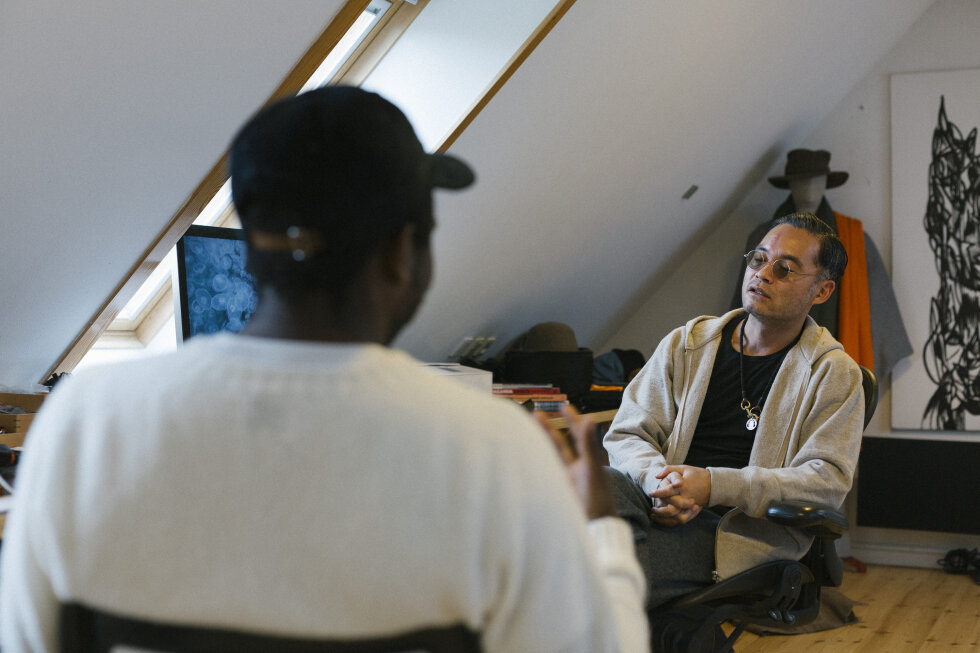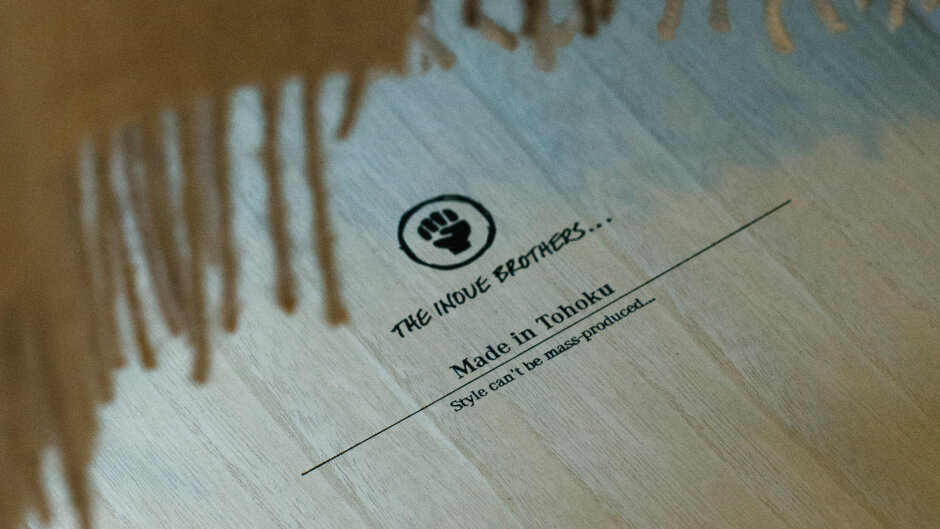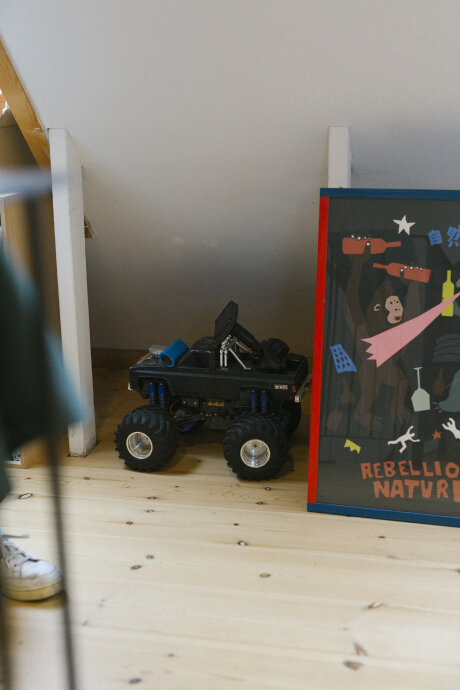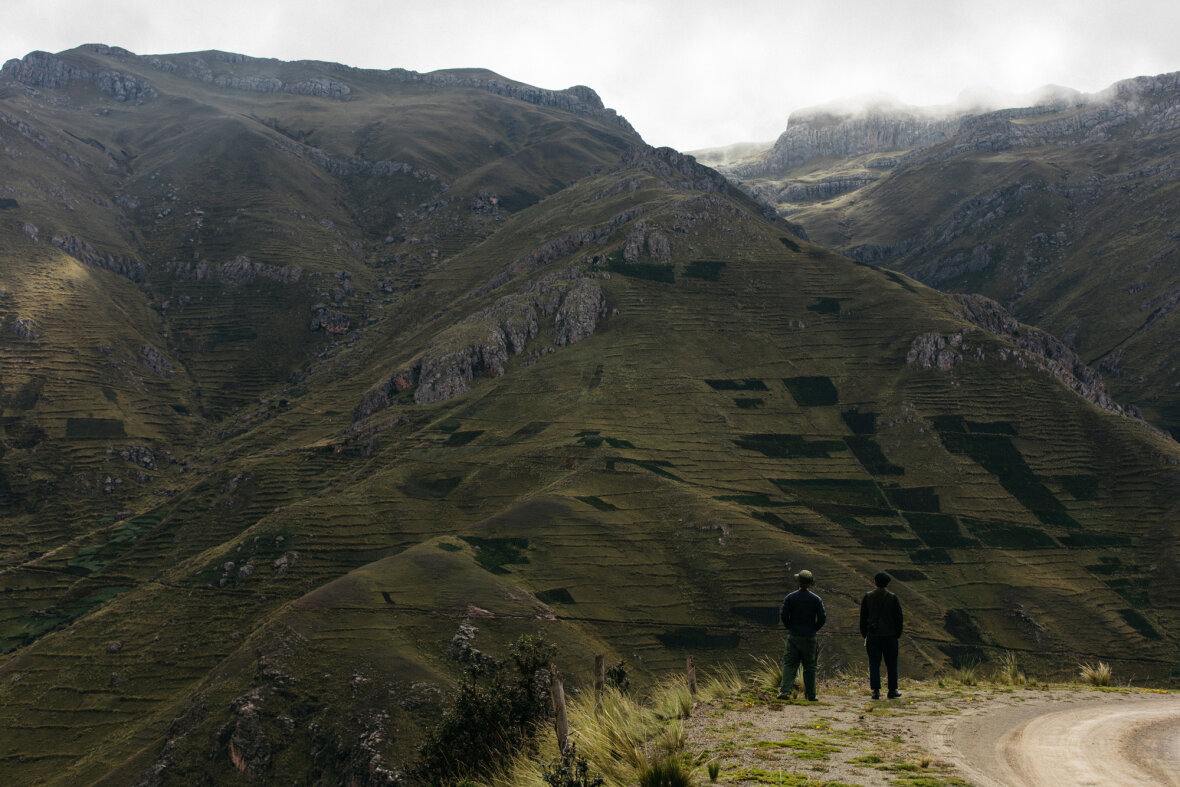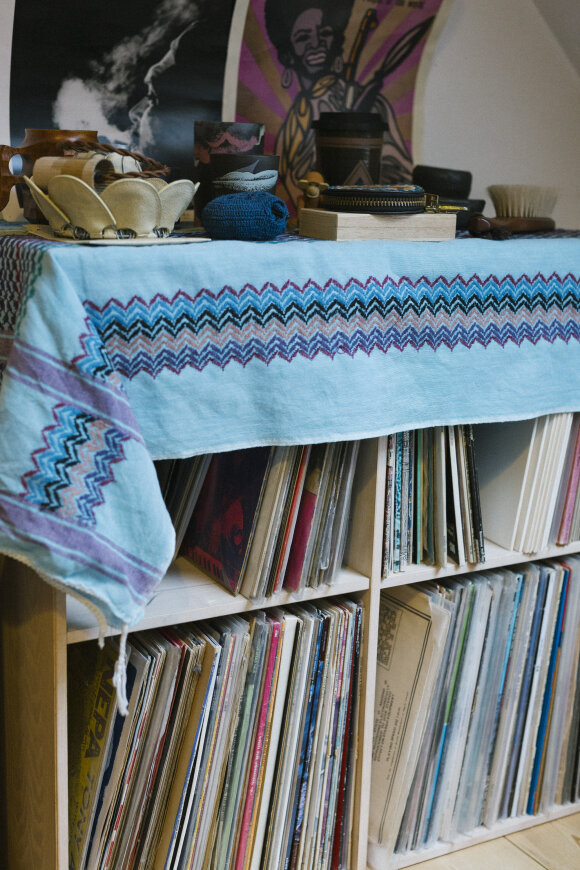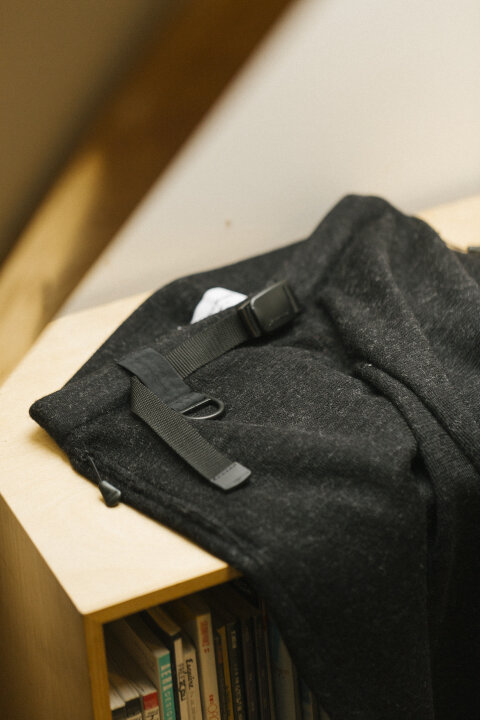- TIME TOGETHER, A CONVERSATION WITH SATORU OF THE INOUE BROTHERS…
- Invited to a secret location, we met Satoru Inoue on a charming street in central Frederiksberg, Copenhagen. A large metal door set in an 18th-century building with cobbled stones led us to the studio. A small back house set on two floors with beautiful blue shutters. Inside, the walls donned sample collections, artwork, first edition publications and a great selection of New Balance Tokyo Design and Hender Scheme footwear sat at the entrance upon our entry. Brother and co-founder Satoru reflects on the process and time together from which their namesake brand worked with Snow Peak to develop their second collection. “It would be something we did together. And because we do it together, it has to be different from what we would do if we were not together. It's like simple as that."
Discover the inspirational collaboration between Japan and Denmark, this Friday 12th November 2021 at Pilestræde 39.
- What was the driving force behind the establishment of The Inoue Brothers?
In 2004, I had a design company with three of the best graphic designers that Denmark ever had. We worked with B&O and Royal Copenhagen, to mention a few. In this process, my everyday started to change because I was very passionate about design; at the same time, my biggest goal was to become a famous designer and become rich. I was 20. At that time, I realized that a lot of my time going from what I love, which is design, became more and more meetings about meetings about meetings.
Many meetings were long and came with thick contracts that you read five pages and started to fall asleep. At the same time, there was a Danish societal shift. A lot of the politics were beginning to go right, and very anti-immigrant, anti-Muslim, a lot of Islamophobia, uncertainty, and fear. It all felt uncomfortable. Through this time, Superflex, an art company based in Copenhagen, I would call it an art collective, created a campaign with posters all over the city saying, "Foreigners, please don't leave us here with all the Danes."
It was at this stage of my career I started to understand budgets and costs. I was surprised; these guys paid to print these posters all over the city, all over town, to tell all us non-Danish looking people, with humour, that we don't represent the political atmosphere right now. We don't hate you. We don't want to kick you out. I was so moved by it, and I was like, these guys are amazing. Then I started looking at their work and noticed they had started this new thing called social design. Graphic design, interior design, whatever method you use, they applied a social aspect to it.
Afterwards, I visited my brother, who had just become the youngest art director at Vidal Sassoon in London. I told him, "Listen, I want to do social design. Let's contribute value to society and use our creative skills and influence. With your skills as a stylist and hairdresser, my skills as a graphic designer, we could start a creative studio together and create value on a social front." We were like, okay, we have to be honest and a hundred percent transparent. First of all, forget all those commercial concepts and blah, blah, blah. We're going to call our studio who we are. The Inoue Brothers..."
- How did you come up with your logo?
AFor me, it was important for the logo to be bold. We chose to find a person we respected and ask them to write our name, and that's going to be the logo, no matter how it looks. Two weeks after our conversation, we found out that Martha Cooper would be in Copenhagen for the book signing of her graffiti book, In retrospect. She was a big inspiration to us. Without her, we wouldn't know about graffiti today. We had to build the courage to get her to write our name.
- Martha Cooper's In Retrospect book signing took place on the opening of Norse Store Copenhagen at the first location some 17 years ago.
- "Listen, we're going to start this design company called The Inoue Brothers."
- Me and Kiyo, we were like, okay, we don't know her. We've never met her before. We just went and bought her book, and then we went up to her and said, "Listen, we're going to start this design company called The Inoue Brothers." Like, "The Inoue what?" "The Inoue Brothers." We spelt it out for her and said, please write it like you would write a note while you were talking on the phone, and we're going to use that as our logo. She looked at us like; you guys are crazy. Then she just wrote it, and that's the logo we use today.
We went back to the studio, looked at the logo and said, okay, we need a symbol. We thought the mission of social design was to shed light on injustice or disharmony in society. We were like, okay, what do we think are the two greatest injustices in the world at the moment? It's the suppression of people of colour and the suppression of women.
We took the feminist symbol of the fight for women in the '70s in Denmark, Rødstrømpebevægelsen, which has this red fist, and then we took the black fist from the Black Panther movement, fused those two fists and made it our symbol. Because this, for us, represents unity in Japan.
We then went on to form our company later in 2004; unfortunately, most of our clients were still from big corporate organisations. Even my brother was still receiving the same jobs before we formed our company, so we were still in the same place. We were growing frustrated because we couldn't get the social aspect into it.
-
How did the alpaca story that you are known for start?
I was sharing my frustration with my friends, and then one day, a good friend of mine who was doing a PhD in politics in Bolivia told me, listen, there is this whole continent called South America. I didn't know anything about it. In South America, everything that connects South America is in the Andes. This is where the Inca culture stems from. I was like, wow, interesting. This culture has been living with this beautiful animal called Alpaca, which offers wool at the same level as cashmere, but they are the poorest people in South America. Bolivia is the poorest country in South America. The alpaca herders are the poorest of the Bolivians. They're like bottom, bottom, but they live next to each other, and in harmony, with this fantastic resource. It's like living with gold and being poor. How can that be?
Then he was doing this whole research program, and he concluded that they needed education. The governments in South America have always discriminated against indigenous people, so they never taught them about manufacturing, engineering, producing, etc.
At the same time, without education, they're so easily manipulated and exploited. It was all the middlemen in the alpaca industry making money. The traders and the herders were not. You can use this story in almost any other natural resource in the world. It's the same story. The people planting the plants, digging for the metals, herding the animals don't get much.
All the middlemen and the big organizations, especially the design companies, make a profit. He said, "If you could empower them with the know-how of design, you could help them a lot, but at the same time get access to resources," which is super rare. We were like, okay. Then he invited me to Bolivia for the first time in 2006. I went, fell in love with the culture, fell in love with the people. They have nothing, right? When you visit them, they will bring out the two chairs for you if they have two chairs. If they have something to eat, they will bring that out to you. They're smiling and happy, but the moment you get sick or in an accident, or something irregular happens, if you're poor, you're poor.
But as long as these things don't happen, they survive on their culture, mentality, way of life and live in harmony with nature. It's a delicate balance. When you go, it can look very romantic. Wow, it changed my life, with all my first world problems, you know what I mean? But at the same time, you also know reality. If you are in an accident tomorrow, you're done. I went there, fell in love with the culture, met with them and said, okay, it's not rocket science. It's wool. Then I have to make knitwear. I have to become a clothing brand.
-
We started the brand not because I wanted to become a fashion designer but because that was the best way to show how fantastic alpaca is.
-
Why the fashion Industry?
We started the brand not because I wanted to become a fashion designer but because that was the best way to show how fantastic Alpaca is. Why do I want to show the world how fantastic Alpaca is? It's because I want to empower the people.
It was a business model based on the needs. Again, as I said before, it's not rocket science. It's like, okay, I have to start knitwear. Kiyo and I were looking at each other; it's like, I've never knitted, I know nothing about knitwear. We just had to start from scratch. The first thing we did was study the big names, Loro Piana, Zegna, Smedley; what makes a Smedley? What makes Loro Piana Loro Piana? What makes Zegna Zegna? Then we started to just research and learn what knitwear is. Then in this process, I think it took us two years. In 2008, we made it; I think it was four sweaters, four styles.
The shapes were okay. You could wear them, but you don't see me wearing them now. Then we were like, okay, this is what we're going to do. That's how it started.
-
How did you get your name out there?
Two good friends who were working at Dover Street Market in London were getting their hair done at my brother's place. My brother was wearing one of our sweaters, and they were like, "Wow, that's a fucking cool sweater." It has this inherent wow effect when you touched it.
They were like, "Okay, we want to sell this in Dover Street on concession, the small popup corner." Then we see how people react. We were like in Dover Street, like, you're kidding us. We said, okay. We made a small, small collection; that we hand-delivered to Dover Street. We came with the garments, set them up, displayed them. Then three months after, DSM came to us and said, "Listen, Rei Kawakubo liked the collection, and she wants to do a Christmas collection this year in December based on knitwear, and she's chosen you; to be a part of it."
This was an immense opportunity; we still were like knitwear, but we didn't know anything. It's like, where do you make the labels? Where do you make hand tags? All this from scratch. Then we realized this collaboration; it was almost like life and death, but also the best project we've ever done. It's like, you have to make a wedding dinner without ever having cooked.
-
We admire the passion that brought you this far. We'd like to know more about how music plays a part in your creative process.
-
"Fashion clothing is, for us, a medium, a tool to spread a message."
-
Yes. As I said, fashion clothing is, for us, a medium, a tool to spread a message. It's the way to show identity. That's how you tell your tribe, where you come from, the rank society. Everything is communicated through what you wear. It's the same today. Do you like hip hop? Do you like reggae? Do you like rock? Do you like punk? Are you into pop? What you wear is directly connected to music all the time. Tribal culture is related to music. It's not something like, "Oh, we love fashion, and we love music." It's the same thing. It's super related, super-connected because our approach has never been fashion is on a deeper level.
Fashion is something you wear, you put on top of you, right? Food is something you put inside you. The same with music; it goes inside you. When you look at this, in Japan, we talk about six senses: the five physical senses, touch, smell, all these, the visual, and hearing. The sixth sense is the consciousness that gathers all this information and makes an impression on you.
This sense is essential, too, because, without consciousness, it wouldn't say anything to me if I touched anything.
Consciousness is a sense too. In Japan, we say the first sense activated in you when you become life, which tells you something bigger than you, is when you hear your mother's heartbeat inside the womb. That's the first time you unconsciously recognize life outside yourself, and you are part of something bigger.
The sound is super powerful. It's even more potent than fashion if you want to inspire people and if you want to move people. That's why fashion has never been able to compete with the music. Music is always ahead.
I would flip the question and say that you're lost if music is not part of your brand identity as a fashion designer. You will always be late. No matter how much you run, how many trend research companies and PR companies you hire, you will always be late. Listen to the music. Listen to the music, and you will understand what it's going on.
That's why music has been a big part of our brand; it's the foundation and the soul. Then clothing and all this stuff are just physical manifestations of what is non-material as music.
-
How do you find working with a family in a creative capacity?
I think for many people, especially working with family, in the beginning, I was also like, is it like risky to work with your wife, for example?
We spend so much time together all the time, so why should we spend more? Maybe work is a good way of balancing it. But to be honest, like I said before, one thing that was becoming frustrating more than anything was when we started to have meetings about meetings. It makes sense if you have planning meetings before you have an important meeting with a client, but when things become complicated within your company, you feel the beginning of division in the company. So, you start to do meetings about internal meetings. That's when it starts to get tricky.
Working with family is different from working with colleagues because it's easier to be cold and heartless towards a colleague. After all, you don't have to see that person again when you leave the office. But if I've hurt my brother or if I've hurt my wife in the working process, I can't escape. I can't just run away because I have to at dinner; I would have to say, "I'm sorry about what I said this morning because I was stressed." I can't run away from my responsibility to my family.
We don't deal with accounts or suppliers where we don't have a direct connection. And through the partnership with Snow Peak, we now have a relationship with Norse Store.
So, it's all about human relations, and it's like, this is community. And community is vital because it allows people to be a part of a movement. Many people are joining the movement because we can all see that something is wrong with doing things right now. And this wrong has happened within our lifetime. This happened in the last, let's say, 20 to 30 years because we were not so worried about climate change or global warming when we were in the 20s. It was like a party, party. And everything was so creative. Everything was so free.
-
How did the partnership with Snow Peak come about?
I think it all came from also again, starting to feel frustrated about seeing all these weird collaborations in the fashion industry. In the beginning, the collab was the big thing, you remember?
During those times when you did a collab, it was captivating. It would be a two world meet. And something new came out of it. And then, this became a business model, suddenly. And then you started to see all these weird collabs. So, what's the unique thing about it? It's like, "Oh, so they chose the colour of the sole. Wow." So, we were like, okay, if we were ever to do a collaboration, it would be not a collaboration, it would be together with.
It would be something we did together. And because we do it together, it has to be different from what we would do if we were not together. It's like simple as that. But still, if we did something together, it would just be like a melting pot or mixing. It was not really necessary, and it didn't really create anything new. So, it would just be like another business model to generate more sales. So, we were like, "Okay, what would be interesting?" We found out that the most considerable talk about our brand in Japan at the moment was that we were so passionate about natural materials, sustainability in the way that it's natural, empowering the people working with the Alpaca.
So, it had a really analogue vibe. So, we thought, "Okay, can this supernatural analogue material work together with a super high-tech, like super tech material?" Gore-Tex or whatever. So, we were starting to think, "Wow, maybe we could do something with Veilance, lining with the alpaca blah, blah, blah." And we started thinking all kinds of things. And then we began to meet people. Unfortunately, most of the potential partners did not share our vision. There was a lot of talk mentioning new technologies adopted by the military with some of the tech firms, and we were like, "Why do you mention armies all the time?" We are not thinking about going into arms or contributing to war. And then we just found out that when something becomes high-tech, so you can wear something super thin and still survive in the polar circle. It ends up in the army because they have the most considerable funding. They have the money. They buy up all these new technologies, and then you can get a lower-tier material for your gloves or whatever, but everything new would go army, army, army, army.
And we were like, "No, we don't want to be associated with armies and arms technology." So, we were like, okay, scratch that idea. We don't want to do collabs with high-tech stuff. So, I've been talking about this with my friends in Japan, and then suddenly a good friend of mine in school, Nagasaki down south, says, "Listen, man, I'm going to open a shop with this Japanese outdoor brand called Snow Peak. You should come and meet with Lisa, who is the granddaughter of the founder of Snow Peak. At the time, she had just started as head designer of Snow Peak Apparel. So, we went to their showroom.
As we talked, she said, "our philosophy is that we are investing in developing some of the best high-tech materials for camping. And I said, "Wow. Camping?" She said, "Yeah. Camping with families." I was like, "Wow. Even better." And then I told her about all these frustrations and experiences that we've had before. And she was like, "Yes." That's why they focused on making specialized high-tech materials, competing with some of the most high-tech. But they would never use it for arms.
-
"We found you." And it was like, "Sister." That's actually the first capsule collection we did. But we did a small... like I think it was four or five styles.
We are only focusing on camping. And we were like, "We found you." And it was like, "Sister." That's the first capsule collection we did. But we did a small, and I think it was four or five styles. The range has doubled in size since. But it's actually because of great admiration for what they're doing. They're promoting their brand through doing camping events. And when they do a camping event, hundreds of people come. The camp makes bonfires like communal bonfires and then gathers 50 people around one bonfire. And it's strangers, and they all start to talk. In Japan, that is so rare.
Over the years, Lisa has since risen within the ranking of Snow Peak to be CEO. And we promised each other to do whatever we can to stay sharp, to make the best alpaca products together until we get old.
-
"And we promised each other to do whatever we can to stay sharp, to make the best alpaca products together until we get old."
